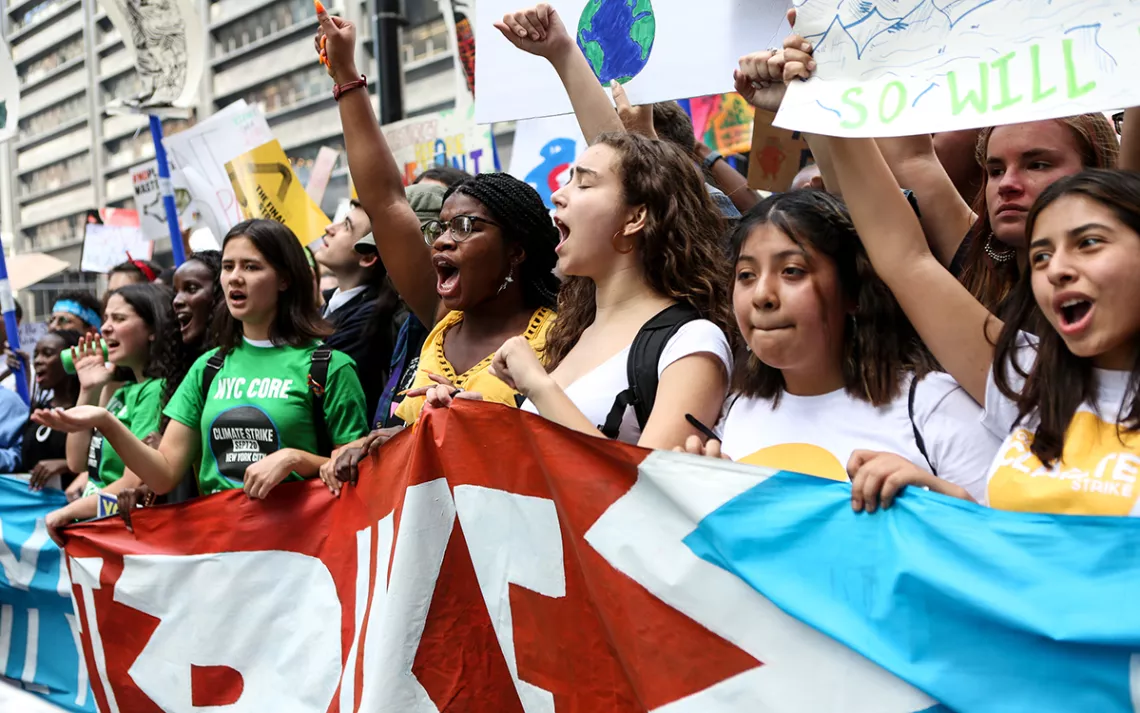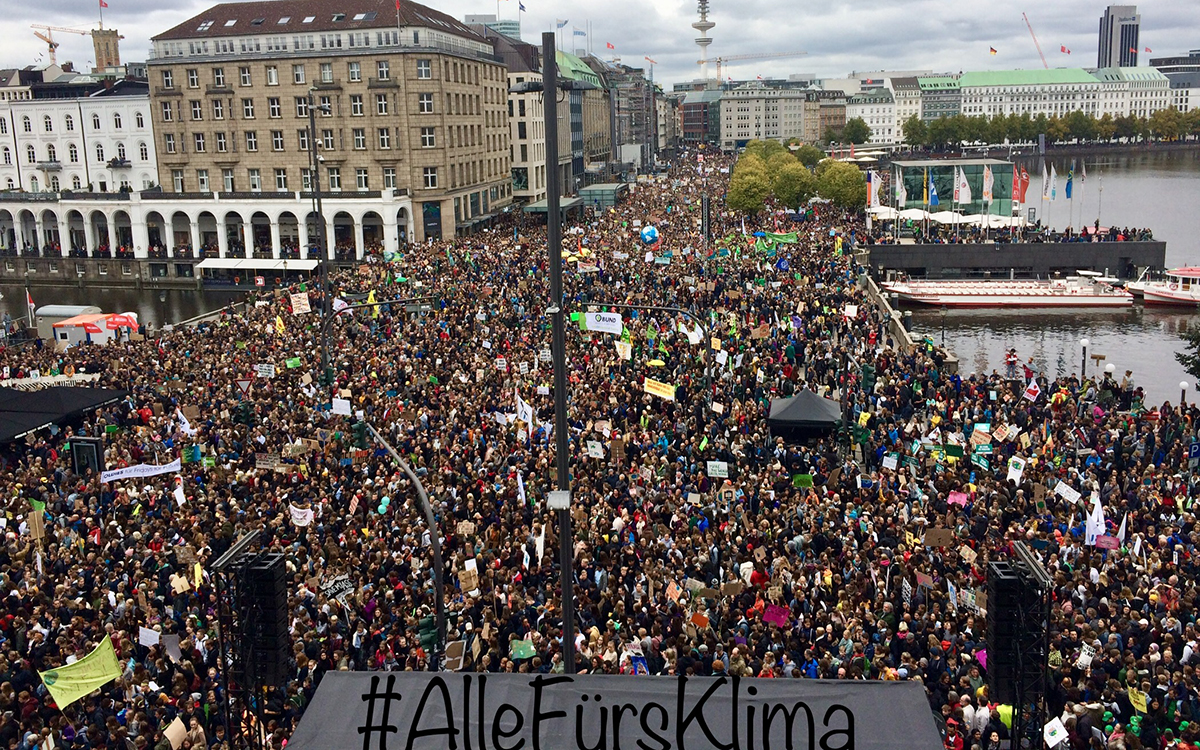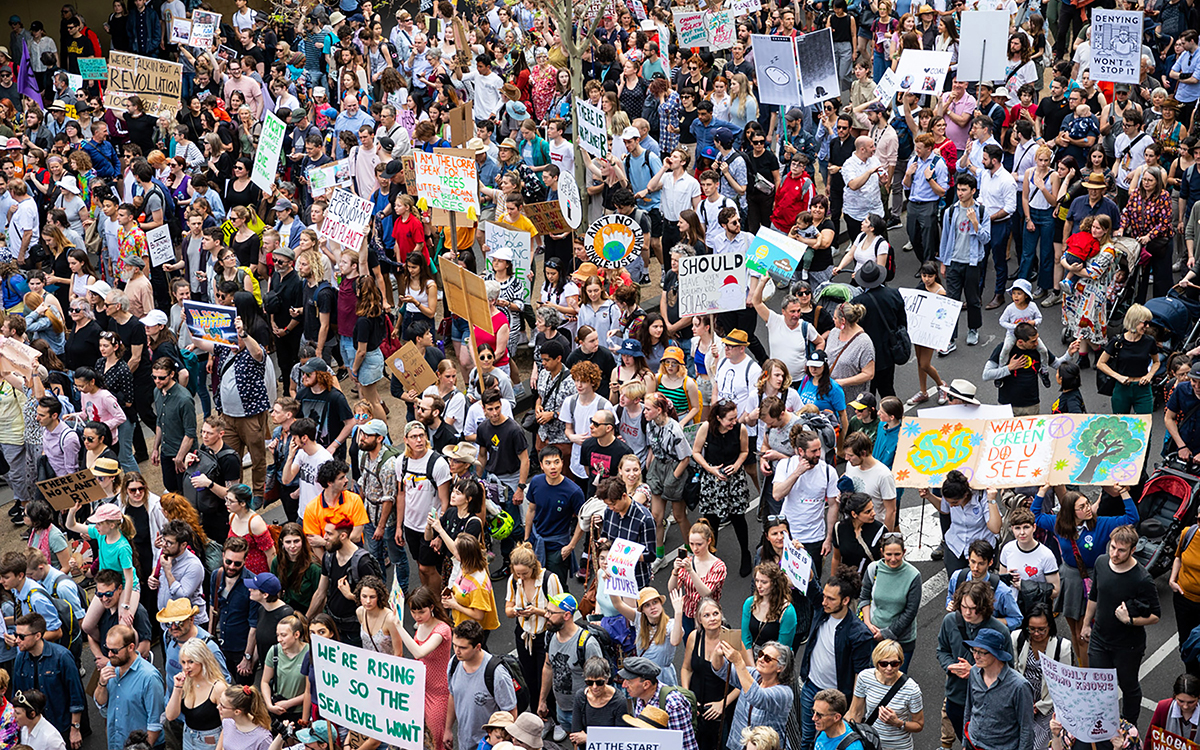World on Fire
Youth-led climate strikes sweep the planet on global day of action

New York | Photos courtesy of 350.org
As the sun rose on Friday morning, the protests began.
In Australia, an estimated 300,000 people clogged the avenues of Brisbane, Melbourne, Sydney, and Perth to demand bold new action to address global climate change. In India, citizens joined youth-led climate strikes in Delhi, Kolkata, and Mumbai to call on their government to reduce greenhouse gas emissions. As many as a quarter of a million people protested in front of the Brandenburg Gate in Berlin—just a fraction of the estimated 1.4 million Germans who protested on Friday—where they chanted for a shift away from fossil fuels and a halt to deforestation. At least 10,000 people packed the Custom’s House Quay in central Dublin, making it the largest climate protest in that country’s history.
And as the sun continued westward, the climate strikes kept spreading.
Tens of thousands of people showed up to strike in Mexico City and Bogota, Colombia. In New York City, hundreds of thousands of students—along with their parents and teachers—jammed lower Manhattan, while in San Francisco a multigenerational, multiracial flood of people poured down the city’s main thoroughfare. Climate strikes were also held in US cities not known for their environmental activism: In Louisville, Kentucky, some 300 people gathered in Jefferson Square Park; in St. Louis, hundreds demonstrated beneath the Gateway Arch; in Houston, marchers braved heavy rains from Tropical Storm Imelda.
No matter where the climate strikes took place, or in what language the protestors sang, the message was the same: It is long past time for the world’s great powers to take swift and sweeping actions to stop the greenhouse gas emissions that are dangerously warming the planet.
“I feel bad about it [climate change] because our world is dying and that’s not good, because we need to have a future,” Amber Simon, a 15-year-old student at Drake High School in Marin County, California, said as she marched through the center of San Francisco; someone behind her held a handmade sign that read "Apocalypse Now," with the Os painted as Earth. “I don’t think adults are dealing with climate change well, because they don’t understand that our world is at a breaking point. If we don’t turn around now, it’s not going to end well.”
"This [climate change] is not right, and we need to change it because we’re the reason that it’s overheating and we should be the reason that it’s saved,” Audrey Gardener, a student at Boerum Hill School for International Studies who attended the Manhattan march, told Sierra. “We need to fix our mess and clean up after ourselves. We can’t leave this for future generations.”
The September 20 climate strikes mark what activists say is the largest single day of climate change demonstrations in history. Inspired by the weekly climate strikes of a 16-year-old Swedish young woman named Greta Thunberg, the youth-led and youth-organized demonstrations on Friday included more than 5,000 local actions in 163 countries and on every continent. As many as 4 million people around the globe participated in the climate strikes, according to organizers with 350.org.
In their breadth, depth, and intensity, the Friday climate strikes represent a strategic escalation for the climate movement: an insurrection against government and corporate elites led by youths who are impatient with the pace of change and unwilling to accept half measures to maintain a livable planet.

Hamburg, Germany

Australia
The climate strikes exhibited much of the usual pageantry of past climate change demonstrations—vibrant chanting and singing and plenty of sardonic signs such as “You Will Die of Old Age, I Will Die of Climate Change” and “Not Old Enough to Watch Porn, but Old Enough to Watch Our Planet Get Fucked.” Yet there was a new emotional tenor in the air, a red-hot urgency for political change.
“It’s upsetting because if we don’t, like, change our environment, we won’t be able to live,” said Jessica Urbine, a 17-year-old student at Lighthouse Community Charter High School in East Oakland. “We’re in danger, and the animals are too—they’re going extinct! Personally, I don’t feel like change is being made, because we’re not being heard. So we have to be loud.”
The young climate strikers made clear that, for them, climate change isn’t simply “an issue”—it is, rather, nothing short of an existential crisis. “This is our planet, and we have to respect it,” said Ivy Silverstein, a sixth grader who attended the Los Angeles climate strike. “I mean, what else are we going to do if we just let it die? We are going to die!”
Climate strikers also showed how, as greenhouse gas emissions and global temperatures continue to rise, teenage angst has been converted into a seething political anger. “The grownups should listen to us and put out a plan to deal with climate change,” said Sam Adeyeye, a 13-year-old eighth grader at the Urban Promise Academy in Oakland.
Ella Barry, a 16-year-old who attends the Benet Academy in Lisle, Illinois, and who helped organize the Chicago climate strike during which thousands of people packed Federal Plaza and spread out into nearby streets, had a similar point of view. “It makes me really frustrated, all of the fossil fuel money in our politics,” she said. “People say, ‘Go out and vote,’ which is great. But if our politicians aren’t going to listen to us and are only going to listen to the fossil fuel companies, that’s really frustrating.”
The climate strikes come just three days before a United Nations–sponsored climate summit in New York, during which UN Secretary General António Guterres will urge countries to make new commitments to reach net-zero emissions by the middle of this century. This coming week, then, will be a test of whether citizens’ anger and impatience can translate into government action.
There is no question that, with the force of their climate strike, the globe’s young people have made themselves heard. It remains to be seen whether they will truly be listened to.
Leanna First-Arai, Austyn Gaffney, and Chloe Zilliac contributed reporting to this article.
 The Magazine of The Sierra Club
The Magazine of The Sierra Club



